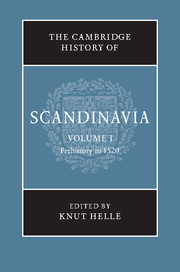Book contents
- Frontmatter
- Introduction
- PART I THE GEOGRAPHY AND PREHISTORY OF SCANDINAVIA
- PART II FROM VIKINGS TO KINGS
- 5 The Viking expansion
- 6 Viking culture
- 7 Scandinavia enters Christian Europe
- 8 Early political organisation
- PART III MATERIAL GROWTH (to c. 1350)
- PART IV THE HIGH MEDIEVAL KINGDOMS
- PART V HIGH AND LATE MEDIEVAL CULTURE
- PART VI LATE MEDIEVAL SOCIETY (c. 1350–1520)
- PART VII SCANDINAVIAN UNIONS (1319–1520)
- Conclusion
- Select bibliography: primary sources, general surveys and secondary works arranged by part
- Index
- Plate Section"
- References
5 - The Viking expansion
from PART II - FROM VIKINGS TO KINGS
Published online by Cambridge University Press: 28 March 2008
- Frontmatter
- Introduction
- PART I THE GEOGRAPHY AND PREHISTORY OF SCANDINAVIA
- PART II FROM VIKINGS TO KINGS
- 5 The Viking expansion
- 6 Viking culture
- 7 Scandinavia enters Christian Europe
- 8 Early political organisation
- PART III MATERIAL GROWTH (to c. 1350)
- PART IV THE HIGH MEDIEVAL KINGDOMS
- PART V HIGH AND LATE MEDIEVAL CULTURE
- PART VI LATE MEDIEVAL SOCIETY (c. 1350–1520)
- PART VII SCANDINAVIAN UNIONS (1319–1520)
- Conclusion
- Select bibliography: primary sources, general surveys and secondary works arranged by part
- Index
- Plate Section"
- References
Summary
For 300 years, beginning at the end of the eighth century, Scandinavians, mostly from what are now Denmark, Norway and west Sweden, figure prominently in the history of western Europe, first as pirates and later as conquerors and colonists. In those centuries other Scandinavians, known as Svear, from east Sweden were active in similar ways in eastern Europe. The people these Scandinavians encountered described them in various ways. In western Europe they were often identified as Danes or Northmen, and were sometimes called heathens or gentiles. In the east the Slavs called the Scandinavian invaders Rus, a word derived from the Finnish name for the Svear. This word, variants of which were used in Arabic and Byzantine Greek, eventually gave Russia its name. In the ninth century it was only the English who called the invaders Vikings, originally a Scandinavian appellative – víkingr; a word that now has a wider meaning and is used to describe not only Viking warriors but also many aspects of Scandinavian society in what is commonly called the Viking Age.
The first recorded raids were on monasteries in the British Isles. In 793 Lindisfarne, an island monastery off the coast of Northumberland, was plundered. A year later raiders who attacked another Northumbrian monastery, probably Jarrow, were opposed and suffered losses. This resistance may have been the reason that in 795 Vikings attacked undefended island monasteries in the west: on Skye and Iona in the Hebrides, and Rathlin off the north-east coast of Ireland. The first recorded raid on the Continent, in 799, was also on an island monastery, St Philibert’s on Noirmoutier, near the estuary of the Loire.
Keywords
- Type
- Chapter
- Information
- The Cambridge History of Scandinavia , pp. 103 - 120Publisher: Cambridge University PressPrint publication year: 2003

